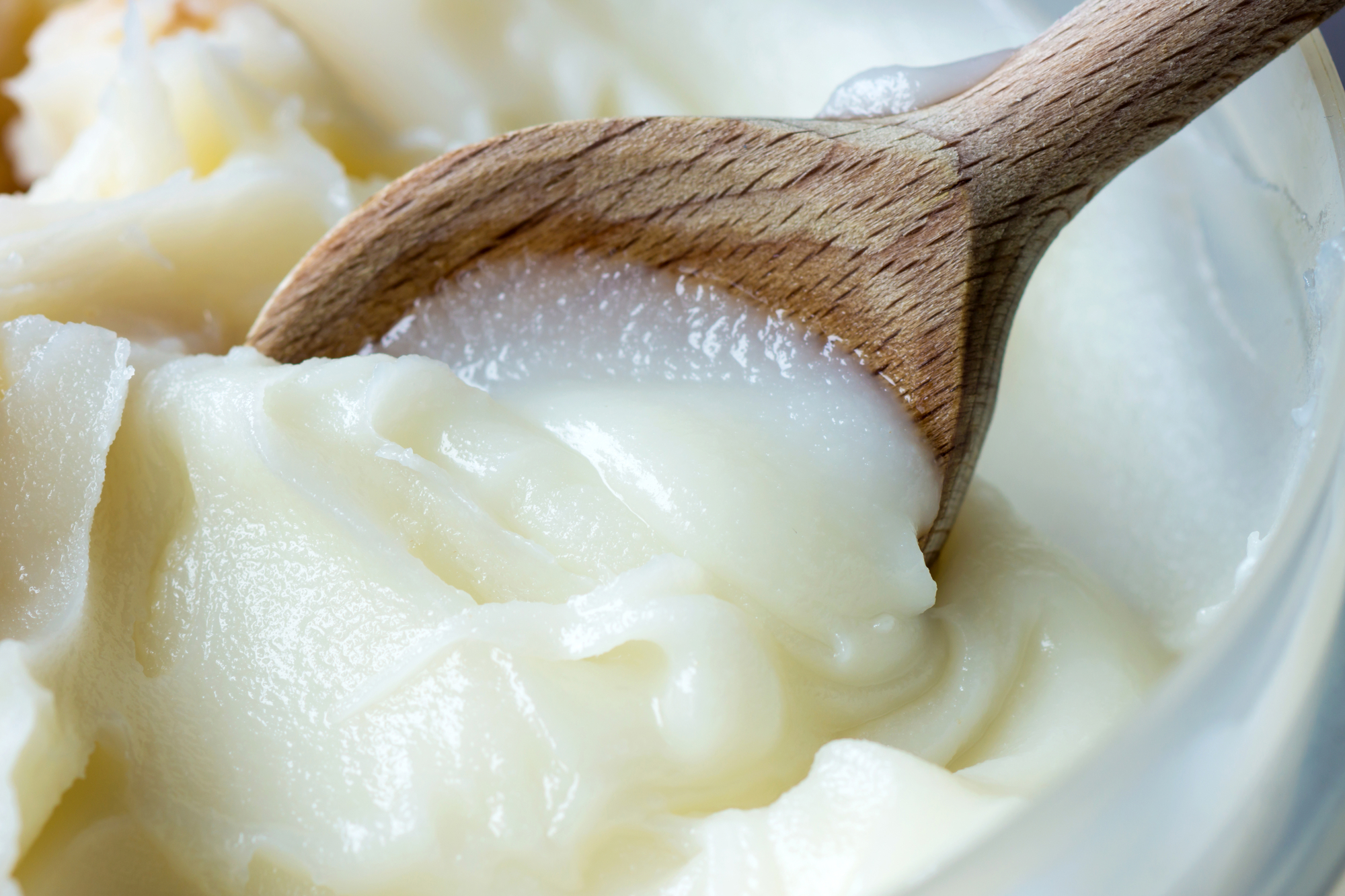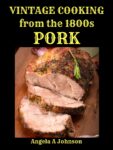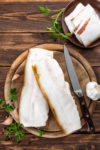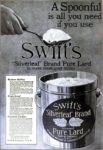
About Lard and How to Render It
LARD is fat from a pig and used for cooking and flavoring. This fat is called lard whether it’s been tried out (rendered) or not.
Trying out is melting fat to skim out the impurities so it is clean to cook with.
INFORMATION BELOW FROM 1800s COOKBOOKS:
PRESSED LARD
Every housekeeper knows how unfit for really nice cooking is the pressed lard sold in stores as the “best and cheapest.” It is close and tough, melts slowly, and is sometimes diversified by fibrous lumps. And even when lard has been “tried out” by the usual process, it is often mixed with so much water as to remind us unpleasantly that it is bought by weight.
THE FINE POINTS IN MAKING LARD
Pure lard should contain less than one per cent of water and foreign matter. It is the fat of swine, separated from the animal tissue by the process of rendering. The choicest lard is made from the whole “leaf.”
Lard is also made by the big packers from the residue after rendering the leaf and expressing a “neutral” lard, which is used in the manufacture of oleomargarine. A good quality of lard is made from back-fat and leaf rendered together. Fat from the head and intestines goes to make the cheaper grades.
Lard may be either “kettle” or “steam rendered,” the kettle process being usually employed for the choicer fat parts of the animal, while head and intestinal fat furnish the so-called “steam lard.” Kettle rendered lard usually has a fragrant cooked odor and a slight color, while steam lard often has a strong animal odor.
Lard should not be suffered to stand long without being tried, because even in cold weather, some parts of it may soon become musty, and nothing can then restore its sweetness.
LEAF LARD
The highest grade of lard, known as leaf lard, is obtained from the fat deposit surrounding the kidneys and inside the loin. Leaf lard has little pork flavor, making it ideal for use in baked goods, where it is valued for its ability to produce flaky, moist pie crusts.
Cut out the kidneys carefully, and remove any bit of lean. Then pull off the thin inner skin, and cut up the leaves —into bits about two inches wide and four long. Wash these quickly in tepid water, drain on a sieve, and put over a slow fire in an iron vessel rather thick bottomed. Add a little cold water—a cupful to a gallon of cut up fat, and let it cook gently until the lumps of fat color faintly.
Increase heat till there is a mild bubbling. Keep the bubbling steady, stirring often to make sure no lump of fat sticks to the pot and scorches. Scorching taints and ruins the whole mass. When the cracklings* are light-brown and float on the top, it is nearly done and should cook slowly.
When done, strain the lard into your vessels with a thin cloth put over a colander. If you put lard in stone or earthen jars, it should be cooled first, as there is danger of their cracking. White oak firkins [casks] with iron hoops and covers to fit tight, are good to keep lard, and if taken care of will last for twenty years. If your family is small, bear in mind that the lard keeps longer in smaller vessels. Set away the jars, closely covered, in a cool, dry cellar or store-room.
* cracklings – crisp, fried bits of fat pork.
LOWER GRADE OF LARD
If leaf lard is not to be had, take ten pounds of solid white pork, as fat as possible. Cut in pieces uniformly the size of your finger, and put in a vessel with a thick bottom—one of iron is preferable—adding one pint of water. Put on the range, keep tightly covered until the water has evaporated in steam, then leave off the cover, letting it cook slowly, until the scraps turn a light brown.
The fat that has the skin on should be cut very fine, taking the skin off first. Soak the inside fat all night in salt and water. Wash it in the morning, and put it to boil without any water in the pot. It is not so nice as other lard, and should be strained by itself. It does very well for frying.
The entrail* fat and bits of fat meat are cooked last and put on top of the other or into separate vessels, to be used during cool weather. This lard is never as good as the other, and will not keep sweet as long; hence the pains taken by careful housewives to keep the two sorts apart. It must be admitted, however, that many persons, when refining lard for market, do not make any distinction, but lump all together, both in cooking and afterward. But for pure, honest “leaf” lard not a bit of entrail fat should be mixed with the flakes.
*entrails – intestines/internal organs.
A PARTICULARLY IMPORTANT POINT
It takes plenty of time to make lard. The cooking must not be hurried in the least. It requires time to thoroughly dry out all the water, and the keeping quality of the lard depends largely upon this.
A slow fire of coals only should be placed under the kettle, and great care exercised that no spark snaps into it, to set fire to the hot oil. It is well to have at hand some close-fitting covers, to be put immediately over the kettle, closing it tightly in case the oil should take fire. The mere exclusion of air will put out the fire at once.
Cook slowly in order not to burn any of the fat in the least, as that will impart a very unpleasant flavor to the lard. The attendants should stir well with a long ladle or wooden stick during the whole time of cooking. It requires several hours to thoroughly cook a vessel of lard, when the cracklings will eventually rise to the top.
While the fat is still quite warm, strain through a colander, pressing the scraps hard with a potato-masher.
A cool, dry room is the best place for keeping lard. Large stone jars are perhaps the best vessels to keep it in, but tins are cheaper, and wooden casks, made of oak, are very good. Any pine wood, cedar or cypress will impart a taste of the wood.
The vessels must be kept closed, to exclude litter, and care should be observed to prevent ants, mice, etc., from getting to the lard. Cover the vessels with closely fitting tops over a layer of oiled paper.
Image from Deposit Photos
=================================================
What Kind of Fat or Oil Do You Cook With? Please Leave a Comment Below,
=================================================
Lard: The Lost Art of Cooking with Your Grandmother’s Secret Ingredient
Lard: The Lost Art of Cooking with Your Grandmother’s Secret Ingredient offers you the opportunity to cook like your grandmother, while incorporating good animal fat into your diet once again. Try your hand at creating fluffy Grandma’s Homemade Biscuits, tasty Spanish Corn Bread, delectable Fried Okra, sweet Chocolate Kraut Cake, a Perfect Pastry piecrust for a delicious Butterscotch Peach Pie, or Rhubarb Dumplings.
Available wherever you buy books online.
=================================================
100% Pure Leaf Lard – Pasture Raised – Non-Hydrogenated – Highest Grade Available – 16 oz
Leaf Lard is still famous and still unrivaled for good reason: it is the best and it produces results that are far superior to any other shortening or cooking oil. Its magic resides in its neutral flavor, its higher melting point and in its ability to turn ordinary food into extraordinary dishes that are delicious, light tasting and light on the stomach. One bite and you’ll understand why this pure white creamy shortening with the nutty aroma has been so well loved for generations. From flaky pie crusts and airy biscuits to crispy french fries, Leaf Lard gives exceptional results.
=================================================
 VINTAGE COOKING from the 1800s ~ PORK
VINTAGE COOKING from the 1800s ~ PORK
by Angela A Johnson
Journey back into the 1800s and discover how people prepared, cooked, and preserved pork, making use of the whole animal. With no electrical refrigeration or modern conveniences, it was a time of thriftiness, resourcefulness, and “making do.”
Recipes Include Pig Feet Relish, German Roast Pork, Boiled Bacon and Cabbages, Bologna Sausage, Pork Apple Pot-Pie, Pork and Peas Pudding, Pork Stew, Baked Pork and Beans, Italian Pork and more.
Available from these online Retailers:
Amazon, Kobo, Apple, Barnes&Noble, Scribd, 24 Symbols, Playster, Angues & Robertson, Mondadori Store, and more.
Also available as Regular Print and Large Print on Amazon.
=================================================




2 thoughts on “About Lard and How to Render It”
Women sure had to work hard back then making everything from scratch. I understand high quality lard is now considered good for you, certainly far better than vegetable oils.
I like cooking, but not to the extent they had to back then; especially with no electricity!